I am very happy.
Soldered in a new A/C-Clock display from Lextreme for $160.00 and he threw in five light bulbs, which allowed me to sneak one in for the emergency flasher switch, looks great . . .
. . . which made me want to tackle the tach/fuel needles that were only half-lit. Took the cluster out:
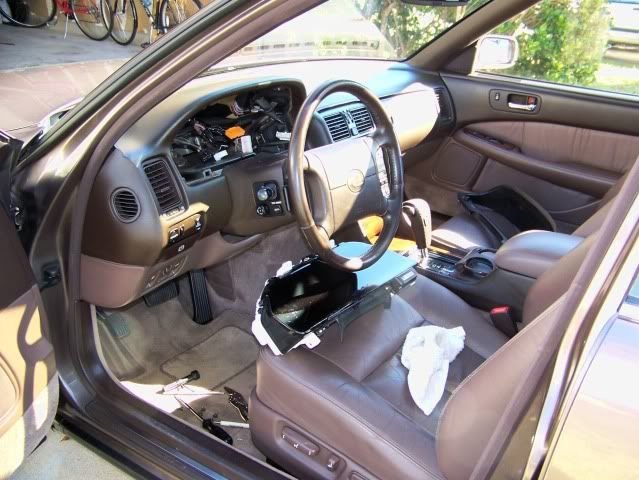
The '92 connectors are not really that bad, a small screwdriver depressing the tab and a sharp little bunt backwards popped them right out with no damage:
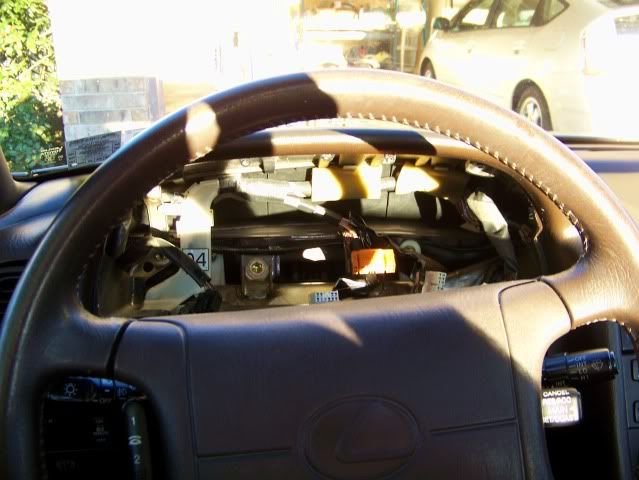
Here is a needle, you can see the black plastic tube surround has cracked and is starting to peel off:
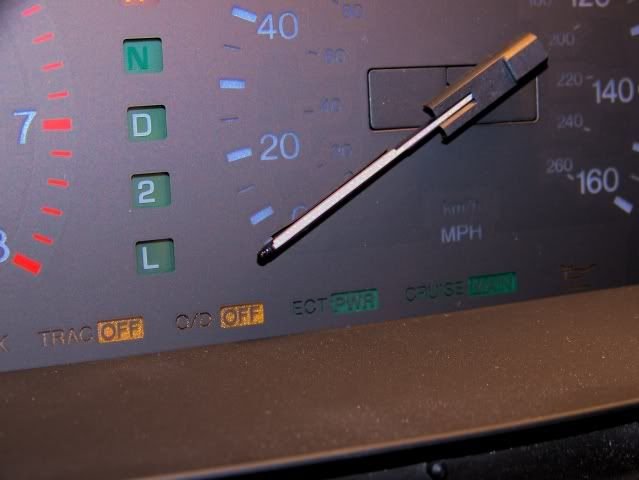
There is no need to go tearing the IC boards or power supply off, a good thing. You will want to take the surround off so you can have better access to the needles:
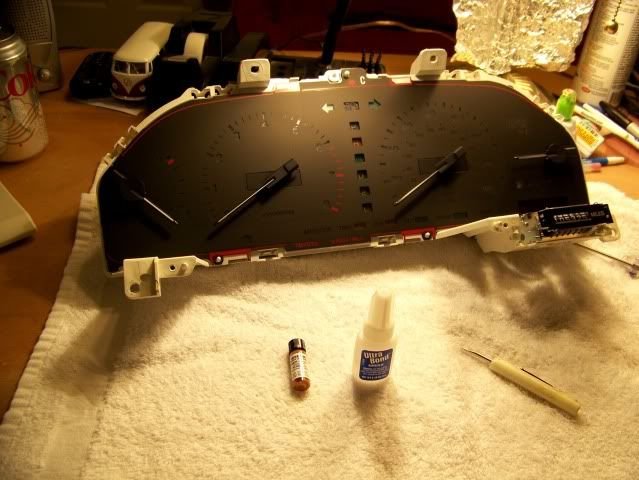
In the foreground of the above shot you will see the fearsome supply of repair needs.
1) a jewelers screwdriver like to tighten the hinges on your reading glasses
2) a tube of rear window defogger repair paint (little thing too)
3) a little tube of SuperGlue®
4) a spare can of Duplicolor *Engine LowGloss Black (*heat resistant)
5) a little paint brush and solvent to clean the brush
A) Put a dab of Superglue on the tip of the jewelers screwdriver and lightly slip it between the flourescent tube and the peeled plastic. Do a little delicate slide along the tube if the plastic has delaminated. Do not allow the Superglue to land on the outside surface of the plastic, get it in between the plastic and the flourescent tube only.
B) oh so very delicately, hold the edge of the tube (needle) and lightly bring the plastic into contact with the tube. Please do not glue your fat finger to the needle. Slide your finger along the plastic a bit and if it appears that you have not glued it to the tube, press the plastic against the tube. "Back-support" the tube any time you apply any force to it. A light pinch between two fingers did it for me, you have to hold it for about 30-60 seconds per breach. Clean the screwdriver with solvent after each application. Do every location that you see a crack in the plastic or a delamination. I had a total of eight cracks and one long delaminate. Be patient. I got two quarters + half time of the Giants and the Eagles in. (Giants lost 45-38)
C) Clean the screwdriver, shake the tiny bottle of "Rear Window Defogger Repair Paint" and apply a little dab of this brown fast-drying paint *across each crack*. Stay away from the illumination strip of the flourescent tube. Also stay away from the gauge background. Please. Apply several light stripes of this too-damn-fast-drying paint. Keep it smooth, it may want to clot. Allow to dry.
D) After it is dry, your needles may look like a dalmation. So, get out the "Low-Gloss" black engine enamel and spray a little shot into the cap. Get your paint brush out and dab black paint over the brown paint. Stick on another coat up both sides of the needle and across the tip, but stay away from the white stripe of flourescent tube.
E) Wash the odometer glass while you are here. Wash the smoked glass cover too with just your hands and dishwashing liquid and do not allow it to hit the kitchen faucet or anything else. Dry. Blow off any lint and only touch the sides. Spot clean the gauge background with a damp paper towel, be delicate. Blow all lint off of everything.
F) Reassemble and stick back into the dash. Cost less than $10.00 and three lazy hours. Voila! Happy! :
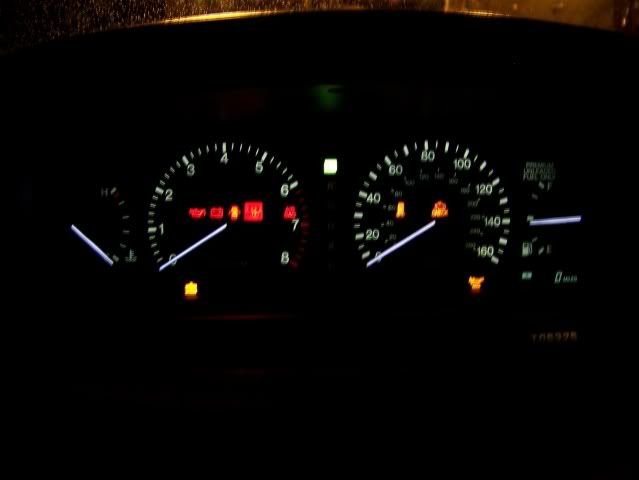
Soldered in a new A/C-Clock display from Lextreme for $160.00 and he threw in five light bulbs, which allowed me to sneak one in for the emergency flasher switch, looks great . . .
. . . which made me want to tackle the tach/fuel needles that were only half-lit. Took the cluster out:

The '92 connectors are not really that bad, a small screwdriver depressing the tab and a sharp little bunt backwards popped them right out with no damage:

Here is a needle, you can see the black plastic tube surround has cracked and is starting to peel off:

There is no need to go tearing the IC boards or power supply off, a good thing. You will want to take the surround off so you can have better access to the needles:

In the foreground of the above shot you will see the fearsome supply of repair needs.
1) a jewelers screwdriver like to tighten the hinges on your reading glasses
2) a tube of rear window defogger repair paint (little thing too)
3) a little tube of SuperGlue®
4) a spare can of Duplicolor *Engine LowGloss Black (*heat resistant)
5) a little paint brush and solvent to clean the brush
A) Put a dab of Superglue on the tip of the jewelers screwdriver and lightly slip it between the flourescent tube and the peeled plastic. Do a little delicate slide along the tube if the plastic has delaminated. Do not allow the Superglue to land on the outside surface of the plastic, get it in between the plastic and the flourescent tube only.
B) oh so very delicately, hold the edge of the tube (needle) and lightly bring the plastic into contact with the tube. Please do not glue your fat finger to the needle. Slide your finger along the plastic a bit and if it appears that you have not glued it to the tube, press the plastic against the tube. "Back-support" the tube any time you apply any force to it. A light pinch between two fingers did it for me, you have to hold it for about 30-60 seconds per breach. Clean the screwdriver with solvent after each application. Do every location that you see a crack in the plastic or a delamination. I had a total of eight cracks and one long delaminate. Be patient. I got two quarters + half time of the Giants and the Eagles in. (Giants lost 45-38)
C) Clean the screwdriver, shake the tiny bottle of "Rear Window Defogger Repair Paint" and apply a little dab of this brown fast-drying paint *across each crack*. Stay away from the illumination strip of the flourescent tube. Also stay away from the gauge background. Please. Apply several light stripes of this too-damn-fast-drying paint. Keep it smooth, it may want to clot. Allow to dry.
D) After it is dry, your needles may look like a dalmation. So, get out the "Low-Gloss" black engine enamel and spray a little shot into the cap. Get your paint brush out and dab black paint over the brown paint. Stick on another coat up both sides of the needle and across the tip, but stay away from the white stripe of flourescent tube.
E) Wash the odometer glass while you are here. Wash the smoked glass cover too with just your hands and dishwashing liquid and do not allow it to hit the kitchen faucet or anything else. Dry. Blow off any lint and only touch the sides. Spot clean the gauge background with a damp paper towel, be delicate. Blow all lint off of everything.
F) Reassemble and stick back into the dash. Cost less than $10.00 and three lazy hours. Voila! Happy! :

